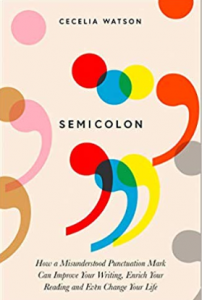
“Manuals viewed all punctuation as pauses of different lengths”


A biography of much misunderstood punctuation mark and a call to arms in favour of clear expression and against stifling grammar rules.
The most recent edition of Chicago manual runs to a 1026 pages and contains 38 semicolon,
Cecelia Watson began teach and that was when she realised that strict rules aren’t always the best way of teaching people how to make words say what they want them to: that they are even, sometimes best ignored.
George Orwell, Stephen King, Hemingway, Vonnegut all hated the semicolon but Herman Melville, Henry James and Rebecca Solnit loved them and thought it is the most divisive punctuation mark in the English language, and many are too scare to go near it.
In Semicolon, Cecelia Watson, a historian and philosopher of science and teacher of writing and the humanities charts the rise and fall of this infamous punctuation mark, which for years was the trendiest one in the world of letters. In the nineteenth century as grammar books became a must, the rules of how we use language became both stricter and more confusing with semicolon a prime victim.
The semicolon mark was born in the Italian renaissance as European printers in 15th and 16th centuries invented many such typographical signifiers- squiggles, dashes, curlicues of all sorts, now, mostly forgotten and can be overused, and there are contexts and genres in which it’s out of place.
In 1875 the Massachusetts state legislature passed a law regulating the sale of alcohol. The law stipulated “ that no sale of spirituous or intoxicating liquor shall be made between the hours of 11 at night and 6 in the morning, nor during the Lord’s day, except if the licensee is also licensed as an Innholder he may supply such liquor to guest who have resorted to his house of food and lodging.” The law was simple only licensed innholders could serve booze past 11. But at some point over the next 25 years the law showhow acquired a semicolon after the word “morning”, with the result that the exception for innholders only applied to Sundays. When the semicolon came to light in the 1900, Boston was thrown into a sic year clash between bars and temperance advocates.
Mrs Watson writes “ There is always joy in mastery of some branch of knowledge, but there is much more joy in understanding how it is that a punctuation mark can create meaning in language that goes beyond just delineating the logical structure of a sentence.”
Semicolon: How a misunderstood punctuation mark can improve your writing, enrich your reading and even change your life by Cecelia Watson £ 8.99.
